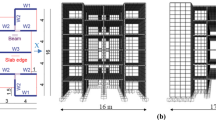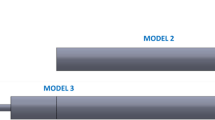Abstract
Since the new tunnel is close to existing tunnel, the vibration wave induced by blasting endangers the safety and stabilization of the surrounding rock and the lining of existing tunnel. In the tunnel blasting vibration monitoring and safety prediction, Peak Particle Velocity (PPV) and vibration frequency are used widely as safety standards. To investigate the effect of blast-induced vibration from adjacent tunnel on existing tunnel, field monitoring experiments and a numerical method that is Finite Element Method (FEM) were adopted to study the blasting vibration velocity and vibration frequency of existing tunnel. Combined blasting vibration velocity with vibration frequency, the paper studied axial and radial blasting vibration velocity distributions and the corresponding Power Spectral Density (PSD) distributions of the existing tunnel under the effect of blast-induced vibration from adjacent subway tunnel. And the parameters of constitutive model and blasting loads were also discussed. It is shown that field monitoring experiment and numerical simulation can optimize blasting excavation program and provide a reference for other similar engineering projects.
Similar content being viewed by others
References
Cao, X. J., Zhang, J. C., Lv, H. L., and Guo, J. Q. (2006). “Numerical simulation of ground vibration effects in shallow tunneling.” Journal of Southwest Jiaotong University, Vol. 41, No. 6, pp. 680–685 (in Chinese).
China Society of Engineering Blasting (2003). Blasting Safety Regulations, General Administration of Quality Supervision, Inspection and Quarantine of the People’s Republic of China, Beijing, China.
Chinese Environmental Protection Bureau (1988). Urban environmental vibration measurement methods, China Standard Press, Beijing, China.
Dai, J. (2002). Dynamic behaviors and blasting theory of rock, Metallurgical Industry Press, Beijing, China.
Li, H. T. and Shu, D. Q. (2005). “Influential factors analysis of blasting vibration attenuation law.” Engineering Journal of Wuhan University, Vol. 38, No. 1, pp. 79–82.
Li, X. B., Ling, T. H., and Zhang, Y. P. (2007). Analysis of blast vibration signals theories and methods, Science Press, Beijing, China.
Li, X. H., Long, Y., Ji, C., Zhong, M. S., and Zhao, H. B. (2013). “Study on the vibration effect on operation subway induced by blasting of an adjacent cross tunnel and the reducing vibration techniques.” Journal of Vibroengineering, Vol. 15, No. 3, pp. 1454–1462.
Liao, Z. P. (1992). “Essential knowledge on wave theory and its preliminary application to earthquake engineering (continued).” South China J. Seismol, Vol 12, No. 4, pp. 77–84.
Liu, H. (1999). “Study progress of influence of nearby blasting on a tunnel.” Blasting, Vol. 16, No. 1, pp. 57–63.
Ministry of Railways of the People’s Republic of China (2007). Railroad tunnel monitoring technical regulations, China Railway Press, Beijing, China.
Ministry of Water Resources of the People’s Republic of China (1995). Standard for engineering classification of rock masses, China Standard Press, Beijing, China.
Nateghi, R., Kiany, M., and Gholipouri, O. (2009). “Control negative effects of blasting waves on concrete of the structures by analyzing of parameters of ground vibration.” Tunnelling and Underground Space Technology, Vol. 24, No. 6, pp. 608–616, DOI: 10.1016/j.tust.2009.04.004.
Second Survey and Design Institute of Railways (1995). Code for design of railway engineering — Tunnel, China Railway Press, Beijing, China.
Singh, P. K. (2002). “Blast vibration damage to underground coal mines from adjacent open-pit blasting.” International Journal of Rock Mechanics & Mining Sciences, Vol. 39, No. 8, pp. 959–973.
Torano, J., Rodriguez, R., Diego, I., Rivas, J. M., and Casal, M. D. (2006). “FEM models including randomness and its application to the blasting vibrations prediction.” Computers and Geotechnics, Vol. 33, No. 1, pp. 15–28, DOI: 10.1016/j.compgeo.2006.01.003.
Wang, S. J., Wu, Z. Y. and Dong, W. L. (1980). Problems of engineering geomechanics for rock mass, Science Press, Beijing, China.
Xia, X., Li, J. R., Li, H. B., Liu, Y. Q., and Zhou, Q. C. (2005). “Udec modeling of vibration characteristics of jointed rock mass under explosion.” Rock and Soil Mechanics, Vol. 26, No. 1, pp. 50–56.
Yao, Y., He, C., Zhou, L. L., and Tong, P. (2007). “Effect analysis and controlled measures research about blasting vibration to neighboring tunnel.” Journal of PLA University of Science and Technology, Vol. 8, No. 6, pp. 702–708.
Author information
Authors and Affiliations
Corresponding author
Rights and permissions
About this article
Cite this article
Zhao, Hb., Long, Y., Li, Xh. et al. Experimental and numerical investigation of the effect of blast-induced vibration from adjacent tunnel on existing tunnel. KSCE J Civ Eng 20, 431–439 (2016). https://doi.org/10.1007/s12205-015-0130-9
Received:
Revised:
Accepted:
Published:
Issue Date:
DOI: https://doi.org/10.1007/s12205-015-0130-9




